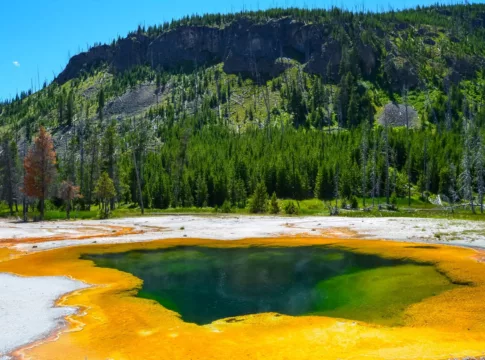Over the weekend, NASA’s Curiosity rover continued exploring the northern end of Texoli Butte on Mars, capturing breathtaking views of the planet’s ancient landscapes. The steep buttes exposed cross-sections of sedimentary layers, offering a detailed record of past surface processes. The rocky terrain in Curiosity’s workspace revealed striking layers and veins, providing valuable insights into Mars’ geological history.
NASA’s Curiosity trekked around the northern end of Texoli Butte


A magma cap beneath Yellowstone National Park
Scientists have identified a magma cap beneath Yellowstone National Park, located about 2.4 miles (3.8 km) below the surface. This cap acts as a pressure-regulating layer, preventing magma from rising too quickly and reducing the likelihood of an eruption. The cap consists of molten silicate materials, supercritical water, and porous rock, which trap heat and gas within the volcanic system. Researchers used seismic imaging and advanced modeling to study its structure.

Novel material can convert CO₂ into fuel
Researchers have developed a stable metalcone thin film for converting atmospheric CO₂ into methanol, a liquid fuel. By mildly annealing tincone at 250°C, they improved its stability in aqueous solutions while enhancing its electrochemical properties. This breakthrough overcomes a major challenge in using Metalcones for carbon reduction applications. The next step involves integrating this engineered material into real-world systems to assess its efficiency in CO₂ conversion. This innovation paves the way for more sustainable fuel production and advances in photoelectrochemical applications.

Martian Clues to Life? NASA Rover Finds Large Organic Molecules on...
NASA’s Curiosity rover has detected the largest organic molecules ever found on Mars—decane, undecane, and dodecane. These hydrocarbons, believed to be fragments of fatty acids, suggest that Mars' organic chemistry may have been more complex than previously thought. The findings support the possibility that ancient Mars had the right conditions for life. Scientists emphasize the need to bring samples back to Earth for deeper analysis, as Curiosity's instruments may not detect even larger, more complex molecules that could further reveal Mars’ potential for past life.

A cost-effective catalyst to revolutionize hydrogen production
Researchers from the Tokyo University of Science developed a new catalyst called bis(diimino)palladium coordination nanosheets (PdDI). These low-cost palladium-based nanosheets perform as well as platinum in producing hydrogen. Created using a simple synthesis process with minimal precious metals, the nanosheets reduce metal usage and lower hydrogen production costs.